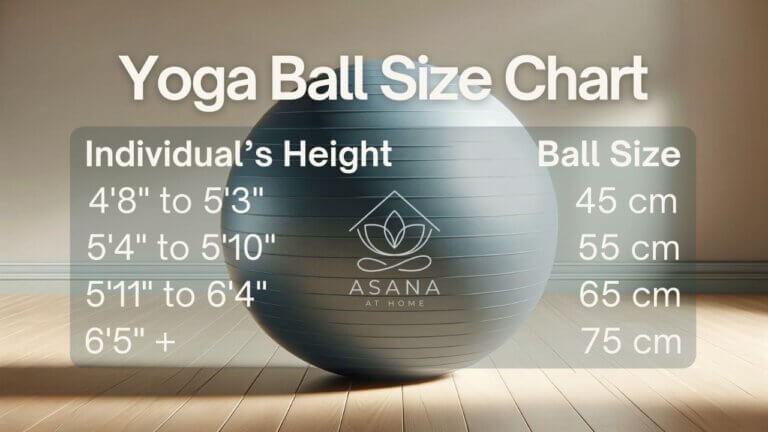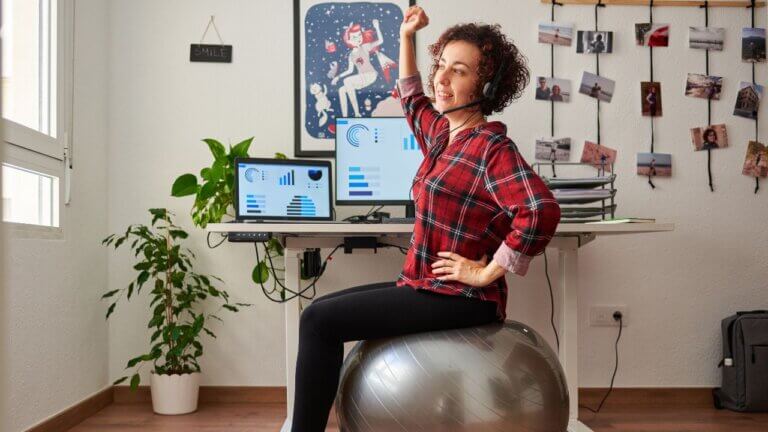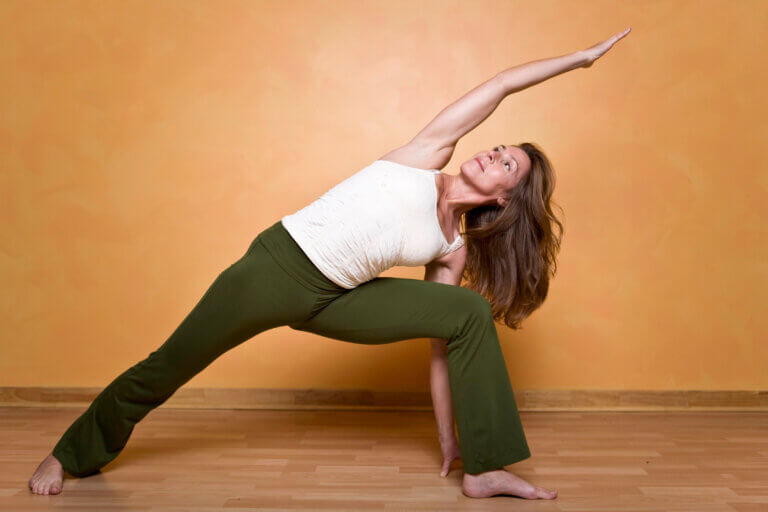Home » Yoga Blog » Yoga at Home Blog » Yoga Ball Size Chart for Exercise and Stability
Choosing a Yoga Ball Size for Exercise and Stability
Understanding the Importance of the Right Size
A yoga ball, also known as a Swiss ball, exercise ball, balance ball, fitness ball, physio ball, and birthing ball, offers remarkable application versatility. Their use spans various settings, including fitness and physical therapy, and even as substitutes for office chairs. However, the underlying importance of these spheres lies in selecting the right size to ensure effectiveness and safety. The challenge of choosing the right size is why I created this yoga ball size chart and guide.
The correct size of a yoga ball is not just a matter of comfort; it is crucial for achieving the desired outcomes, whether enhancing physical fitness, aiding in recovery during physical therapy, or ensuring ergonomic seating in the office.
Critical Factors in Selecting the Right Yoga Ball
When choosing the right yoga ball, several factors play a pivotal role. The most significant of these is the user’s height, the weight limit of the ball, and the intended use.
User’s Height: The individual’s height is critical because a ball that is too small or too large can lead to discomfort and ineffective exercises. Each height range corresponds to a specific ball diameter, ensuring the user can sit on the ball with their feet flat on the ground and knees bent at a 90-degree angle.
Weight Limit: Every yoga ball comes with a maximum weight capacity. Choosing a ball that can support your body weight is essential to prevent injury and ensure the ball’s longevity.
Intended Use: Whether the ball is for fitness routines, rehabilitation in physical therapy, or as an ergonomic office chair, the intended use influences the ideal size. For instance, a ball used for sitting at a desk chair might differ in size from one used for core-strengthening exercises.

Why Selecting the Right Size Matters
The impact of the ball size on core strength, spinal stability, and posture is critically important. A correctly sized ball engages the core muscles, enhancing strength and stability while encouraging good posture.
Furthermore, using yoga balls on various surfaces, such as a flat surface versus unstable ones, alters the difficulty and effectiveness of different exercises. For example, using a yoga ball on an unstable surface can introduce additional balance challenges, further engaging core muscles and enhancing stability training.
The Yoga Ball Size Chart Explained
Understanding the Size Chart
Selecting the right yoga ball size is pivotal for ensuring effective and safe workouts, and a yoga ball size chart is a crucial tool in this process. The chart helps users determine the ideal ball size based on height, correlating it with the diameter of the ball measured in centimeters (cm).
Yoga Ball Size Based on Height

Here’s a general guideline for choosing a yoga ball size based on height:
- For individuals around 4’8″ to 5’3″, a 45 cm ball is typically suitable.
- Those between 5’4″ and 5’10” would benefit from a 55 cm size exercise ball.
- For heights ranging from 5’11” to 6’4″, a 65 cm ball is often recommended.
- Taller individuals, over 6’4″, may find a 75 cm ball more appropriate.
It’s important to note that these are general guidelines based on average height within a range. Users should also consider their body proportions, like leg and torso length, as these can affect the ideal and correct exercise ball size.
The Yoga Ball Size Chart - Beyond Selecting for Height
Beyond height, pay attention to the ball’s maximum diameter and air pressure. Overinflating a yoga ball can lead to a higher burst risk, compromising the user’s safety. Conversely, underinflating can reduce the ball’s effectiveness in stabilizing the core and other muscles during exercises. The ball should be inflated to a point where it’s firm but has a slight give when pressed.
Additionally, when seated on the ball, your hips and knees should ideally form a 90-degree angle with the floor. This position ensures proper posture and alignment, crucial for getting the most benefit from yoga ball exercises.
In summary, understanding and following the size chart is vital for choosing the best size yoga ball that offers the maximum benefit, ensures safety, and enhances the effectiveness of your workouts, core exercises, or therapy sessions.
You Love Yoga, We Love Yoga—Let’s Stay Connected
Get yoga tips, a little inspiration, and friendly emails—because yoga is better with friends.
Special Yoga Ball Size Considerations for Different Uses

When selecting a yoga ball, it’s essential to consider its intended use, as this can significantly influence the appropriate size and type of ball needed. Here are some specific scenarios.
For Physical Therapy
Popular with physical therapists, yoga balls are a tool for various exercises, from improving balance to strengthening core muscles. Patients with specific injuries may need a smaller ball for targeted exercises, while others may benefit from a giant ball for general stability and balance training. The physical therapist’s guidance is crucial in determining the right size for therapeutic goals.
For Pregnancy (Birth Ball)
Pregnant women often use yoga balls, also referred to as birthing balls, for exercise, comfort, and labor preparation. A slightly larger ball is generally more comfortable for pregnant women, as it provides better support for the lower back and can adapt to changes in the body’s center of gravity. Safety and comfort are paramount, so choosing a ball that allows easy movement and stability is essential.
For Office Use
A yoga ball as an office chair can help improve posture and engage core muscles throughout the day. The ideal size should allow the user to sit comfortably at their desk, with their feet flat on the ground and hips and knees at a 90-degree angle. Typically, a ball size between 55 cm and 65 cm works well for standard desk chair heights.
Quality and Safety
Regardless of the use, selecting a high quality, anti-burst ball is crucial for safety. The quality of the ball is essential when the ball is used under significant weight or for dynamic exercises. In its design, Anti-burst yoga balls should slowly deflate if punctured, reducing the risk of injury.
Adjustments for Specific Goals
For goals like core stability challenges or weight training, users might need to adjust the size of the ball. A giant ball can increase the challenge by creating more instability, while a smaller ball might be easier to control for specific exercises. It’s always advisable to start with basic exercises and gradually progress to more challenging workouts as strength and balance improve.
Understanding the specific requirements and intended use of a yoga ball is vital for choosing the right size ball. Whether for therapeutic, prenatal, or office use, the right yoga ball can enhance the effectiveness of exercises, improve comfort, and ensure safety.
Tips and Best Practices for Yoga Ball Use
Incorporating a yoga ball into your routine requires more than choosing the correct size. Here are some tips and best practices to ensure you get the most out of your yoga ball:
Maintaining Good Posture and Alignment
Proper posture is crucial when using a yoga ball. Aim to keep your spine aligned and your core engaged, whether sitting or exercising. Posture not only enhances the exercises’ effectiveness but also helps prevent injuries. When in a sitting position, your hips and knees should ideally be at a 90-degree angle, with your feet flat on the floor.
Correct Inflation
Inflating the ball to the right level is critical. A properly inflated ball should be firm but with a slight give. This balance provides the necessary support while allowing for a range of movements during exercises. A hand pump is usually the best tool for inflation; many yoga inflatable balls come with one. Overinflation can make the ball too complex and unstable, while underinflation can diminish effectiveness.
Safety Considerations
Always use the yoga ball in a safe environment. Clear the area of sharp objects that could puncture the ball. Additionally, starting with exercises requiring less balance is advisable for beginners or those with balance issues. Gradually increasing the difficulty of the exercises as you become more comfortable can help prevent falls or injuries.
Regular Use and Experimentation
Regular use of a yoga ball can significantly improve balance, core strength, and overall fitness. Don’t hesitate to experiment with different exercises and uses of the ball. From stretching to strength training, the versatility of a yoga ball can add variety and challenge to your workouts.
By following these tips and best practices, you can ensure a safe, effective, and enjoyable experience with your yoga ball. Whether for fitness, therapy or as an alternative to a traditional chair, a yoga ball can be a valuable tool in your health and wellness arsenal.
Final Recommendations
Choosing the correct size yoga ball is crucial for adequate exercise, safe therapy sessions, or ergonomic office seating. Regular use and experimenting with different sizes can provide varied and beneficial workouts. Integrating yoga balls into your lifestyle can significantly contribute to overall health, fitness, and well-being. Remember, the perfect ball size can make a difference in your yoga ball experience.
Source Wikipedia





